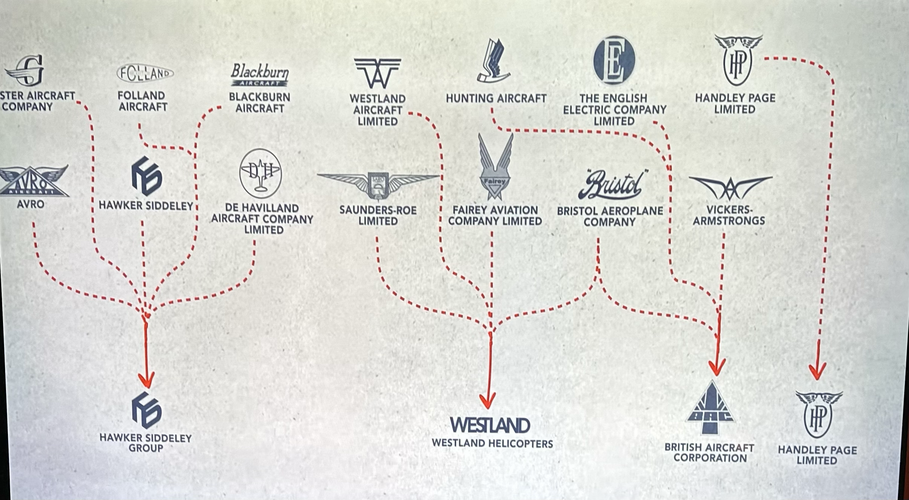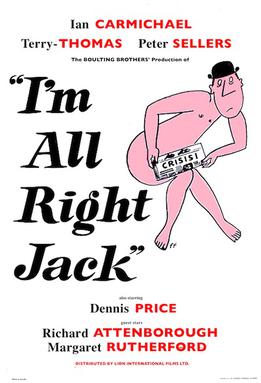In the Wesworld naval role-playing game/forum, I came up with a rationalised industry in the 1930s-40s. I don't offer this as a complete solution (because that setting had a ITTL beginning in 1917) but as where my thoughts were on this subject a decade ago and which are applicable to this scenario in terms of scale of workload and possible trends.
I made three main 'conglomerates' and some smaller groups as follows.
Hawker Siddeley Group
Since its formation in September 1935 the Hawker Siddeley Group has been the largest and of the “Big Three” conglomerates in the British aeronautical industry. It controls the interests of four aircraft manufacturers and one aero engine manufacturer and owns a large portion of the nation’s aviation private R&D facilities. Since 1935 centralisation has been increasing, this year (1949) the Hawker Siddeley Group has been reorganised.
Hawker Siddeley Group Ltd. is the main company overseeing the Group.
Hawker Siddeley Aviation Ltd. has been created from the assets of Gloster Aircraft Ltd. and Armstrong Whitworth Aircraft Ltd. and will focus on aircraft manufacture and component work, repair work and development of guided weapons and other aviation-related items.
A.V. Roe Aviation Ltd. is responsible for all civilian and heavy military aircraft design and their construction at Chadderton and Woodford.
Hawker Aviation Ltd. is responsible for military aircraft design (fighters, trainers etc.) and their construction at Kingston-on Thames and Dunsfold.
Saunders-Roe Ltd. (Saro) at East Cowes has become the naval aircraft design specialist as well as some advanced project work. Saro is also responsible for the helicopter design team at Weston-Super-Mare.
Avro Canada is now a direct subsidiary company rather than managed by A.V.Roe. Armstrong Siddeley Motors Ltd. and Air Service Training Ltd. remain unchanged.
British Combined Aircraft Corporation (BCAC)
Originally formed in March 1943 as the Bristol Vickers Aircraft Company with the merger of Vickers-Supermarine and Bristol (including Bristol engines). In 1944 Westland joined and the current name was adopted. Vickers-Armstrongs is the majority shareholder, while other major shareholders are John Brown & Co. Ltd. and Associated Electrical Industry Ltd. In March 1948 Percival Aircraft Ltd. was acquired from the Hunting Group Limited (the holding company of Hunting & Son Ltd.) in return for a 10% share in BCAC. There has been consolidation of design teams and production facilities, Weybridge is the main design centre, Filton handling rotary-wing work and Yeovil maintains a design team under W.E.W. Petter. All Bristol designed commercial aircraft are marketed under the ‘BC’ label and Vickers commercial aircraft ‘VC’. Percival types will retain their original designations for the time being but commercial types will be marketed under the ‘PC’ label. The titles BCAC (Vickers-Supermarine), BCAC (Bristol) and BCAC (Westland) are still in use for some marketing products.
AIRCO
AIRCO, the third conglomerate in the industry formed on March 6 1938 when Handley Page Ltd. merged with de Havilland and in August 1941 Fairey Aviation Co. Ltd. joined. Each company trades individually but there is close co-operation between design and sales teams and joint use of research resources. AIRCO controls; Handley Page Aircraft Ltd, de Havilland Company Ltd., de Havilland Australia Pty Ltd., de Havilland Canada Ltd., de Havilland Forge Ltd., de Havilland Engine Co. Ltd., AIRCO-Reed Propellers Ltd. (merger of de Havilland Propellers Ltd. and Fairey-Reed Ltd.), Hearle-Whitley Engineering Co. Ltd., Airspeed Aviation Ltd. (now de Havilland’s Christchurch Division), Fairey Aviation Co. Ltd, and Avions Fairey in Belgium.
National Electronic Engineering Limited (NEE)
Formed in 1940 by the merger of English Electric, Napier & Son, Napier-Paxman and Paxman. In 1944 it acquired Alvis Car and Engineering Company Ltd. and in 1945 acquired the Marconi Company to become the biggest electrical engineering, industrial engineering and electronics manufacturer in Britain.
[Note in this scenario English Electric did not build aircraft but this company covers Alvis and Napier aero-engines.]
Blackburn & Boulton Paul Group
In March 1949 Boulton Paul Aircraft Ltd. merged with the Blackburn Group (which includes Blackburn Engines Ltd.) to form a wide-ranging group covering several aspects of aviation engineering. The Dumbarton works is run jointly with William Denny & Bros. Ltd.
Boulton Paul owns a majority 51% stake in Martin-Baker Company Ltd.
General Aviation (UK) Ltd.
Formed in early 1944 by the pooling of the aviation interests of Parnall Aircraft Ltd., which owned the patents, patent rights and designs of Nash & Thompson Ltd. and the Hendy Aircraft Co., with those of Portsmouth Aviation. In March 1947 the Navarro Aircraft Construction Company also merged with the company to secure capital and construction facilities for the Tribian Sponson.
Maintenance and repair services at Portsmouth, includes contract with Portsmouth, Southsea & Isle of Wight Aviation.
Design and manufacture of powered-gun turrets for aircraft by Nash & Thompson Ltd. at Yate.
Independent Companies
Aero Engines Ltd.
Builders of 23hp Sprite and 50hp Pixie.
F.M. Aspin & Company Ltd. Ltd.
Development and manufacture of auxiliary power-units for large aircraft.
Manufacture of engines and gearboxes for the automotive industry.
Auster Aircraft Ltd.
Chilton Aircraft Ltd.
Including Owns Carden Aero Engines Co., building engines for ultralight aircraft based on the Ford Ten car engine and Chilton Electronics Ltd., founded in 1946, parent company of the Chilton group, manufactures the Chilton shaver socket and circuit breakers.
Dart Aircraft Ltd.
(premises shared with Hawkridge Aircraft Company).
Hawkridge Aircraft Company
(premises shared with Dart Aircraft Ltd.).
Manufacture, maintenance and repair of gliders.
Heston Aircraft Company Ltd.
Other Work:
Sub-contract work for de Havilland for structural elements and components for NEE aero engines.
Jameson Aero Engines Ltd.
Jameson 1, 100hp, 4-cyl four-stroke piston engine, certificated 1945.
Martin-Baker Company Ltd.
Boulton Paul owns a majority 51% stake in the company. Undertakes research, development and manufacture of ejection-seats for aircraft and other life-saving devices for pilots.
Miles Aircraft Ltd.
Other Work:
Operation of the Aeronautical Technical School in Reading.
Other business interests include Philidas Ltd. producing locking nuts, Copycat Ltd. manufacturing photocopiers and the Miles Martin Pen Co. Ltd.
Reid and Sigrist Ltd.
Other Work:
Manufacture of precision aircraft instrumentation, notably turn and slip indicators invented by George Reid, the Gyorizon (combined turn indicator and artificial) and 3-axis gyroscopes at New Malden.
Operation of a civilian flying training school at Desford.
Repair contracts with the RAF, work undertaken at Desford.
Rolls-Royce Ltd.
Works: Derby, Derbyshire; Glasgow, Lanarkshire and Barnoldswick, Lancashire. (The factory at Crewe, Cheshire is now totally dedicated to motor car production.)
Rolls-Royce has a 50% stake in Rotol Airscrews Ltd. along with the Bristol Aero-Engine Company Ltd.
Scottish Aviation Ltd.
Other Work:
Flying school and maintenance contract work at Prestwick.
Operates Scottish Airlines (Prestwick) Ltd., the airline undertakes worldwide passenger and cargo charter flights to destinations all over Europe, Africa, the Middle East, India, Canada and the United States from its base at Prestwick.
Short Brothers (Rochester & Bedford) Ltd. and Short & Harland Ltd.
Short & Harland Ltd. at Belfast undertakes a wide range of other aviation and non-aviation related engineering work.
Subsidiary Pobjoy-Short at Hooton Park, Cheshire, designs and manufacturers auxiliary accessory gearboxes and auxiliary power units in co-operation with Rotol Airscrews Ltd.
Slingsby Sailplanes Ltd.
Tipsy Aircraft Company Ltd.
Tipsy Junior, single-seat light aircraft, Belgian prototype OO-TIT first flown 30 June 1946, licence-production began September 1947.


